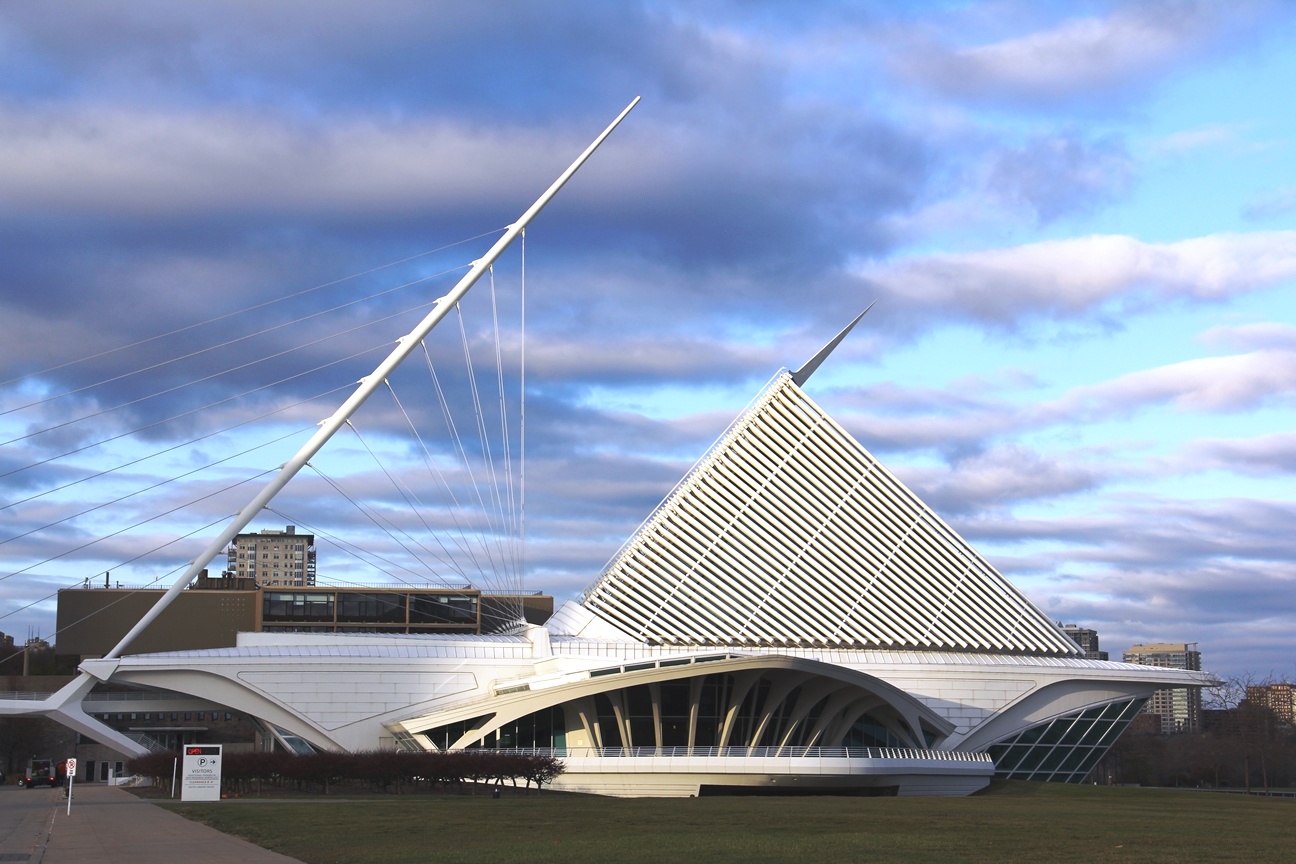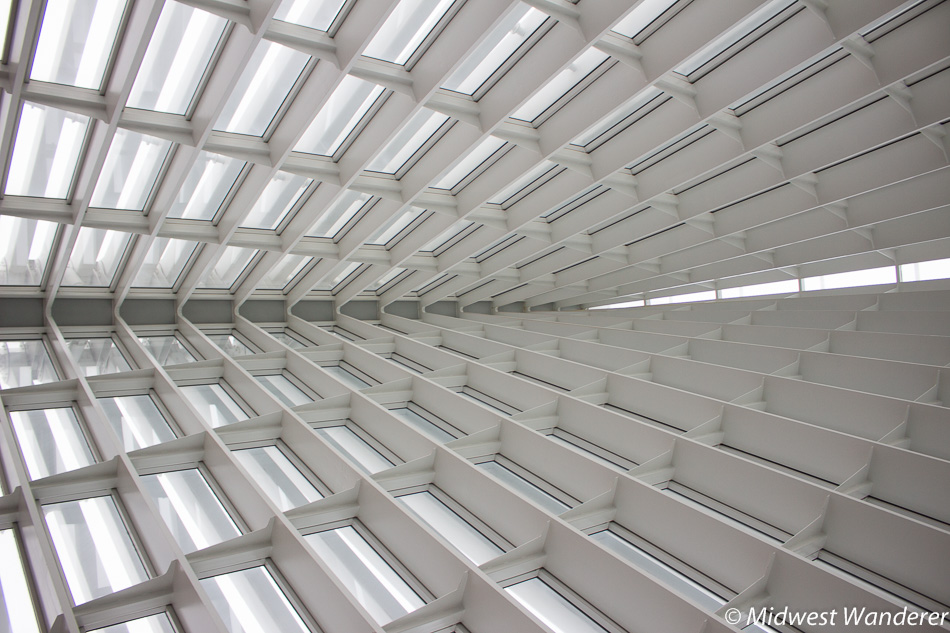The Milwaukee Art Museum, one of the oldest art museums in the nation, reopened its Collection Galleries last week following a renovation six years in the making. The $34 million renovation added 16,000 square feet of space and completely transformed placement of artwork and wayfinding. The new east end addition opens the museum once again to the beauty of Lake Michigan, right outside its doorstep, and the remodel of the oldest museum sections creates an easy flow from one area to another with surprises around every corner.
We took a peek at the changes during a media preview a few weeks ago as the final touches to the renovation were being applied. Having never been to the museum before, we can’t compare the old with the new, but what we saw was impressive.
The preview started with a short ceremony in the Quadracci Pavilion, the 2001 addition that is an artwork in itself. The sculptural architecture, designed by Santiano Calatrava, stretches to the Lake Michigan shore. Its “wings” that span 217 feet fold and unfold twice daily. Inside, the vaulted glass ceiling soars 90 feet high.
Milwaukee Art Museum Tour
Unlike the 2001 addition, which was more about the building than the art itself, the latest renovations focus on art placement and the visitor experience while viewing the art. Dan Keegan, Director of the Milwaukee Art Museum, pointed out how exhibits and the building have been rearranged as he led us on a tour. Before the renovation when you walked down the Quadracci Pavilion galleria to the older areas of the museum you saw just a dark opening with no idea of what was in the space beyond. Now the area pops with a large pop-art Tom Wesselmann painting of a Pabst Blue Ribbon beer can, a nod to Milwaukee’s beer history.
 As you make your way from gallery to gallery, every time you turn a corner, you face a hint of what you’ll see in the next gallery, usually with a single, large piece of art. Without much signage you know whether you’re entering an area of classic art or modern. Newer art is displayed in bright white cube space, whereas walls in galleries that exhibit older, historic art are painted rich colors.
As you make your way from gallery to gallery, every time you turn a corner, you face a hint of what you’ll see in the next gallery, usually with a single, large piece of art. Without much signage you know whether you’re entering an area of classic art or modern. Newer art is displayed in bright white cube space, whereas walls in galleries that exhibit older, historic art are painted rich colors.


 In salon-style galleries paintings and ornate furniture are grouped together, just one of the ways that museum staff were able to display an additional 1,000 works of art than was previously exhibited.
In salon-style galleries paintings and ornate furniture are grouped together, just one of the ways that museum staff were able to display an additional 1,000 works of art than was previously exhibited.
 Dan mentioned that wayfinding throughout the museum, which was previously confusing, is now made easier with a dominant west-to-east flow. Passageways that didn’t exist before have been opened up, adding more exhibit space. In addition, another 16,000 square feet of space was added with the new east end building. The floor-to-ceiling glass walls on the east side of the new addition allow visitors a clear view of Lake Michigan, also aiding in visitor orientation.
Dan mentioned that wayfinding throughout the museum, which was previously confusing, is now made easier with a dominant west-to-east flow. Passageways that didn’t exist before have been opened up, adding more exhibit space. In addition, another 16,000 square feet of space was added with the new east end building. The floor-to-ceiling glass walls on the east side of the new addition allow visitors a clear view of Lake Michigan, also aiding in visitor orientation.
 The upper floor in the east end addition includes a sculpture gallery and a resting area for visitors with plenty of seating. A lakefront entrance to the museum has been added on the first floor of the addition, which also includes space for a coffee shop or wine bar.
The upper floor in the east end addition includes a sculpture gallery and a resting area for visitors with plenty of seating. A lakefront entrance to the museum has been added on the first floor of the addition, which also includes space for a coffee shop or wine bar.
The new 10,000 square foot Herzfeld Center for Photography and Media Arts debuted in the renovation, as well, making the Milwaukee Art Museum one of just a few museums in the United State that have a dedicated space for photography.
Don’t miss a Midwest Wanderer post. For a FREE subscription, enter your e-mail address in the Subscribe2 box to the right and click Subscribe.
Other changes in the museum include adding exhibit space on the mezzanine level dedicated to folk, self-taught and outsider art.

 They have also moved the education area to a space within the art experience itself. Many art museums designate a separate area for education away from exhibit space. Also, what used to be called the “permanent collection” is not so permanent anymore, as pieces will rotate over the years, creating ever-changing experiences for returning visitors.
They have also moved the education area to a space within the art experience itself. Many art museums designate a separate area for education away from exhibit space. Also, what used to be called the “permanent collection” is not so permanent anymore, as pieces will rotate over the years, creating ever-changing experiences for returning visitors.
More about the Milwaukee Art Museum
The Milwaukee Art Museum history dates back to 1888 when gallery owner Frederick Layton and other individuals formed the Milwaukee Art Museum. The Frederick Layton collection is still on display in the museum.
As the museum expanded, rather than trying to compete with the neighboring Art Institute of Chicago, the Milwaukee Art Museum complemented it with their own art styles, heavy in German expressionism, since Milwaukee had a large German population. Today the Milwaukee Art Museum holds 30,000 works of art and is the largest art museum in Wisconsin.
If you go
The Milwaukee Art Museum, located at 700 N Art Museum Drive in Milwaukee, Wisconsin, is open Tuesday thru Sunday (closed Mondays, Thanksgiving and Christmas Day). Check the web site for hours, admission rates and other details.
Disclosure: My visit to the Milwaukee Art Museum was hosted by the Visit Milwaukee, but any opinions expressed in this post are our own.
Thank you for reading Midwest Wanderer. Don’t miss a post. Enter your e-mail address below and click Subscribe to be notified whenever I publish another post. Subscription is FREE. After subscribing, be sure to click the link when you get the e-mail asking you to confirm.


